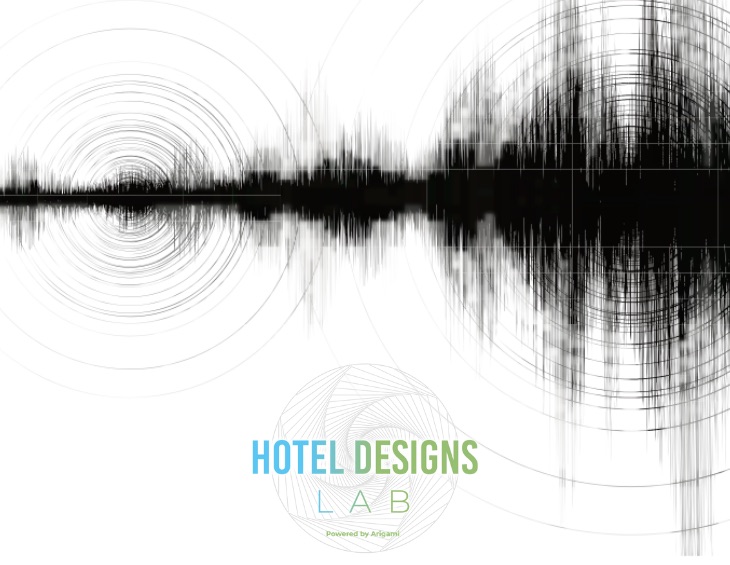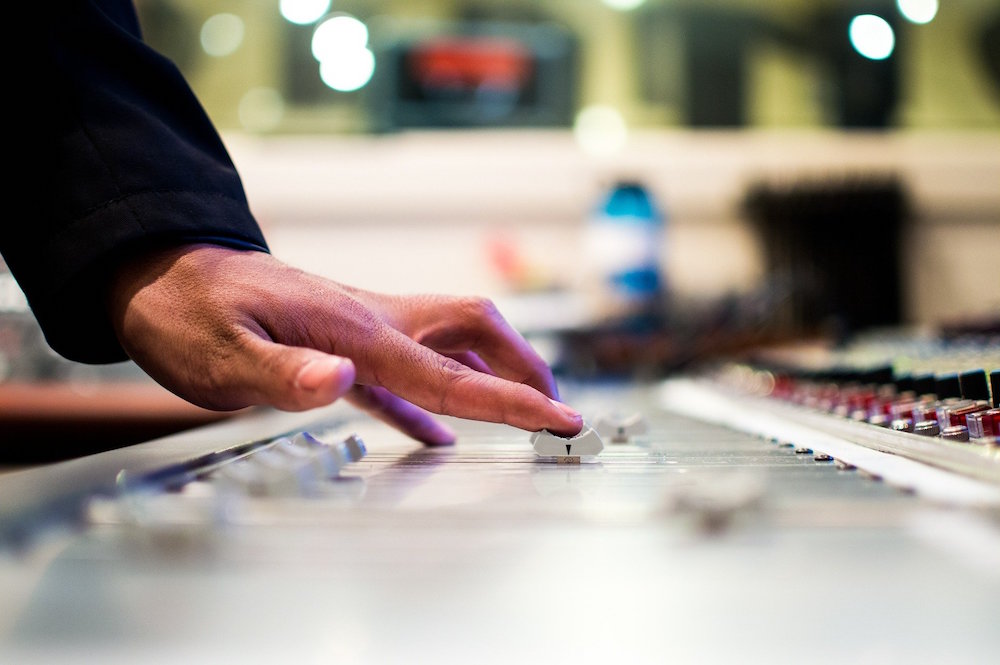Hotel Designs LAB, powered by Arigami and published exclusively by Hotel Designs, is a series of thought-provoking articles developed to challenge the conventional hospitality landscape and, in the process, empower interior designers, architects, hoteliers, developers, technologists and hospitality brands with actionable design insights. In our first article of the series, Robyn Landau, Katherine Templar-Lewis, Ari Peralta and Ramy Elnagar explore sound design and guest wellbeing…

The global health and wellness market is currently witnessing exponential growth. Being a hotel is not what it used to be. Technology, societal changes and post-pandemic pressures continue to shape today’s hospitality industry, making it critical for hotels to adopt new design-thinking. And as we evolve our definition of wellness ‘beyond the spa’, we are encouraging industry stakeholders to pivot to a more holistic, interdisciplinary, and evidence-based approach to hospitality design. This means working with experts from different disciplines and integrating science into the foundation of hospitality design.
The industry’s approach to sound often focuses on the content sound, culminating in generic music playlists being played in any given zone. By designing for, and working ‘with’, sound as it interacts with materials, shapes, technologies and other senses, we can create hospitality environments and sonic spaces that contribute to the positive health of travellers globally. Recognising a need for a new way of integrating sound into hospitality design, we spoke to Tom Middleton, functional soundscape designer and psychoacoustic expert for Calm; Paul Oomen, founder of the Spatial Sound Institute and professor John Drever, sound practice research at Goldsmiths University, who each acknowledged the importance of sound from the start of the design process.
- An interdisciplinary approach to sound
- Sound and our body
- Sound and perception
- Sonic strategies to promote guest wellbeing
“Sound energy and content help determine the function of the room in itself.” – Paul Oomen, founder of the Spatial Sound Institute.
An interdisciplinary approach to sound
With a renewed commitment on health and wellbeing, design firms are accepting a need for specialist collaborations but must also expand their approach to sound by working with experts at the intersection of science, tech and design. Sound can no longer be considered in isolation. Current sound strategies often focus on sound content, generic music played in a zone. We want to challenge designers to do better, and shift their thinking into sound context. Designers need to take responsibility for guest health and safety through an interdisciplinary lens to dissect and “connect” the layers involved. Tom Middleton, sound architect who has worked with leading hospitality brands such as Yotel, explains: “My career has been spent coming in at the last minute with clients saying, ‘oh and we might need some sound on property’, and at that point it’s too late.” Paul Oomen, founder of the Spatial Sound Institute is encouraging hospitality designers to think of the interplay of sound sources, systems and content from the beginning. “If sound is an afterthought, it makes it very hard to match things,” he says. “Sound energy and content help determine the function of the room in itself.”
“It takes only 0.146 seconds for the brain to respond to an audio signal.”
Sound and our body
Do not underestimate the power of sound. The fastest of all our senses, it takes only 0.146 seconds for the brain to respond to an audio signal. As the second most memorable sense after smell, sound can influence all other senses. As sound moves through the spaces we design, it touches everything around it, interacting with the shapes, materials and sizes of a space, and those who inhabit it. It strikes every cell and organ, vibrates our bones and activates our muscles. It is therefore key to redefine listening as a holistic experience.
Several modern products, many of which are found in guestrooms and public areas, emit very high (infrasound) and very low (ultrasound) frequencies that can cause harm to human health. Most of us don’t consciously hear these sounds, but our brain and bodies still feel them. Lights, alarms, and bird and rodent repellers all emit very high frequencies. Professor Drever says: “They may be inaudible to some, but to others like children and infants, it can make them nauseous, uncomfortable, even cause pain.” In the same way, low frequency sounds, below 20Hz, emitted by large industrial fans, fridges and air conditioners have long wavelengths that travel through walls creating strange patterns in space. As many of these come on at night, they can pose problems to a guest’s restful night’s sleep.
Sound and perception
We all hear and perceive sounds differently, from our range of hearing to our reactions to sound. Professor Drever has pioneered this field of study, termed Auraldiversity. He says: “As we go through life or even throughout our day, we know our hearing isn’t fixed.” These changes can be caused by a range of triggers including bouts of anxiety, fatigue, jet lag, a migraine after an indulgent night out, or natural shifts with age. Drever points out that a beautifully designed toilet full of chrome, marble and glass is peaceful until you use the hand dryer. The sound bouncing off the reflective surfaces can multiply the sound of the hand dryer up to 19 times. Add a metal swing bin without a rubber stopper and you have a cacophony of noise creating the opposite effect intended by the smooth calming marble and expensive soft hues.

Image credit: Pixabay
Sonic strategies to promote guest wellbeing
There is a significant amount of evidence and complex research that can be intimidating to most design firms. The following key insights promote sonic strategies that enhance wellbeing:
1) Go beyond content and sound systems
“Enhancing a particular mood can be steered with very simple elements, but this starts from designing that from the beginning,” says Oomen. “You cannot just talk about a perfect ‘sound system’, everything needs to be tuned together. Once you understand this, it is very simple.” Moving away from the mentality that having a certain type of music or a high-quality sound system is enough, is the first place to start, remembering things have to make contact with each other.
“Before Tom Middleton enters the studio to create a functional soundscape, he works with his clients to understand the goals of a space.”
2) Think of the relationship between sound and function
A fundamental truth is that context is key to design strategy. What are you trying to achieve and what is the purpose of the space? Before Middleton enters the studio to create a functional soundscape, he works with his clients to understand the goals of a space. Do you want a sense of activity or a more relaxed perception? Observe the guests, and talk to them. How are they using it? What are the patterns in mood and behaviour? Create mini living labs within your own hotel, using behavioural science and neuroscientific thinking. What shapes within the natural space do you have to work with, and how can you maximise those? “Spatial sound for me in essence is about relating physically to sound that is in a room,” adds Oomen. Working in this way can help reduce costs for overly acoustically treating a space.
3) Make sound dynamic and interactive
People are not static, and sonic strategies need to work with the flow and density of human movement. Support the guest journey and consider where the guests have come from, where they are going prior to, during and after their stay. How can sound enhance this? For example, the Dubai airport is tackling overcrowding without frenetic announcements, with a crafted soundtrack that acts like a watch mechanism that pulses and shifts momentum to encourage calm movement of travellers through the terminal. Craft the soundscapes to expose guests to tones conducive to their wellbeing needs and expectations. Studies at the Spatial Sound Institute show that levels of relaxation can be increased in a matter of minutes by exposing the person to a particular depth and presence of sound. Considered sonic interactions are vital to help a guest feel more relaxed and safe.

Image credit: Pixabay
4) Get creative and pragmatic
Remember sound design strategies should be customised. Soundscapes are an effective way to develop sonic branding, creating a memorable experience, building brand loyalty. As Middleton explains: “You’ve got a blank canvas with a hotel… zones could potentially have an optimised soundscape. What does that sound like, and how do you make it align with brand values? That’s where you start having fun and you can start to play. What cultural references, geographical, political, demographical, plugins can you pool together to align with an experience in a particular location that delivers what it needs to for a particular audience,” Oomen reminds us, “How can you work with the particular distribution of sounds in a zone, and acknowledge the character of a space?”
“Sound architecture for me is going to become very exciting when humans within the space are creating the soundscape.” – Tom Middleton, sound architect.
5) Embed data into sound design
New technology is emerging that makes personalisation and responsive design easier to implement. This includes capturing key details about guest personality type, purpose of travel and circadian rhythm, or smart buildings and IOT to connect with wearables to track guest stress and health levels. Intelligent sound design considers time of arrival and the purpose of trip with sound that responds to changes throughout the day or seasons. Middleton is highly optimistic about this future. “Sound architecture for me is going to become very exciting when humans within the space are creating the soundscape. Whether it’s tracking your heart rate with locators and sensors as you move through space.”
What’s ahead?
Opportunities to optimise interactions with sound across the hotel guest experience will lead the industry to evolve its thinking from “music playlists” to “sound spatialisation”. The sound quality of everyday experiences have serious consequences on wellbeing, and now, more than ever, intelligent and collaborative design is necessary for the wellness and safety of hotel guests. We’re reaching out to hoteliers and sound experts alike to bridge the innovation gap and initiate interdisciplinary collaborations across the industry to raise the bar in sound architecture and with guests’ sonic experiences.
Arigami is a research and innovation consultancy focused on wellbeing. We help our partners strategise, validate and measure wellbeing. We believe the industry must evolve, and with nimble research, we can maximise the impact of wellbeing strategies. It’s time to work together to transform hospitality into the leading industry combating anxiety and stress and improving the health of travellers globally.


